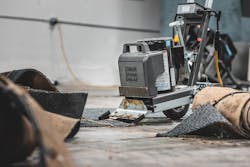Not Like That! Top Mistakes When Using Floor Scrapers
The more often you drive, the more comfortable it becomes. After 10 or more years, driving becomes second nature. It’s no different in the construction industry when working with the same equipment every day. But when we get too comfortable, it’s easy for little slip-ups to sneak their way in, in the same way drivers can pick up bad habits over time. To help crews overcome productivity barriers on the job site, Dave Bigham, global director of training at surface preparation equipment manufacturer National Flooring Equipment, highlights some bad habits he often encounters with people using scrapers.
When it comes to scraper faux pas, it’s not always due to a lack of care. Often, there’s a multitude of reasons why crews are using equipment wrong from lack of equipment training to wrong tooling choice, but the end result is the same―delays that could have been easily avoided. Depending on the issue, production can grind to a halt entirely, taking a few days to rectify the issue. So, how does this happen?
Unprepared
Insufficient preparation can result in poor surface preparation. This could mean having the wrong tooling or scraper, or not having enough equipment to complete the job on time. A bad habit that some crews fall into is the idea that once at a job site, you have to work with what you got. Insisting on continuing a job without the proper tools can take even longer than if teams went back to base to get what they need. If problems do occur from incorrect tooling, the job would need to be put on hold until the correct tooling was on the machine and any damage to the floor surface must be corrected, increasing project time.
Machine size
Another issue is using the wrong size or type of equipment for the job. Before going to any job site, it’s important to know what the situation is to better plan what kind of scrapers are required. Factors that impact the type of equipment used include, how big the space is, whether the scraper will need to move up and down stairs, and how small individual rooms are if there is more than one space. It will also indicate how many scrapers are needed and the tools needed to accompany them, like grinders, dust collectors, and shanks.
Machine use
What’s important is understanding how to use your equipment. With various solutions entering the market, it can be difficult to keep up with the latest training manuals. Most floor scrapers require very minimal maintenance, as long as contractors use the machine as intended. To ensure success, first make sure the scraper is set up correctly: has the speed control been set to the right level? Are the wheel pins in? Most machine suppliers will have a variety of training and operating resources to use if crew members are unsure.
Avoiding stick ups
Heavy-duty adhesive residue can be left on the subfloor after removal and must be fully removed before any new floor can be laid on top. If left behind, new flooring may be uneven and its longevity will be reduced. Assessing the floor type will help determine what method is needed for example, vinyl flooring may require heat application to soften the adhesive, while tile or hardwood requires scoring ahead of scraping.
Cleaning as you go
When removing flooring, it’s usually the job of the contractor to safely dispose of any waste. During floor removal and clean-up, contractors must prioritize their safety and wear protective gear such as face masks and dust collectors to minimize the inhalation of dust. A common mistake we see is contractors sweeping up the dust left behind, but this can cause serious health problems if breathed in, even if others in the area are using dust collectors. Floor sweepers can also be used to help collect debris so that polishers can then buff the floor surface.
While being a seasoned contractor means you work like a well-oiled machine, it’s important to look for ways to improve and knock out any vices that affect the quality and effectiveness of the job, no matter how comfortable they may seem. While tried and true methods used at the start of your career may get the job done, there is so much best practice advice out there to help make surface preparation easier and more productive.
Need help kicking your bad habits? Visit https://nationalequipmentdirect.com/resources.
